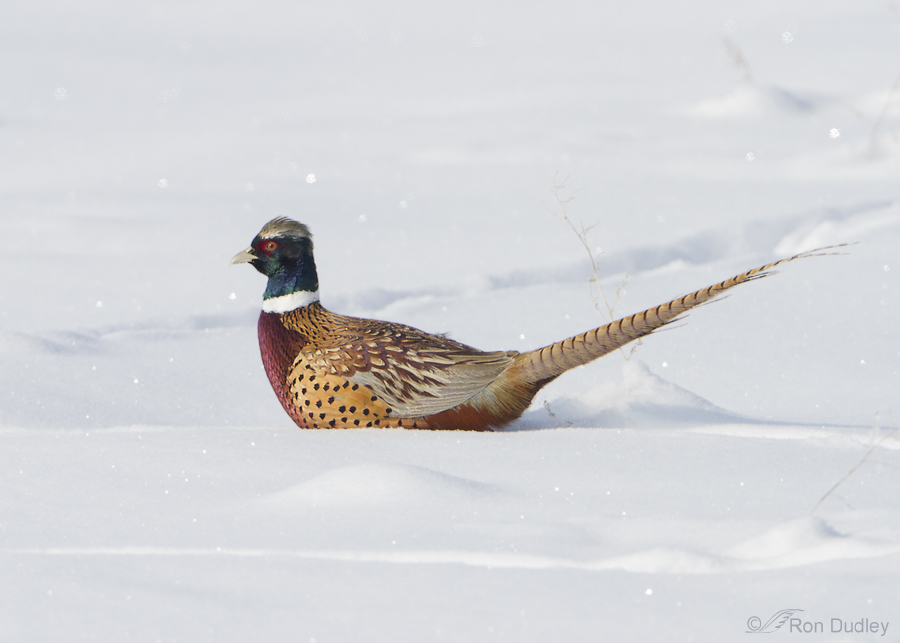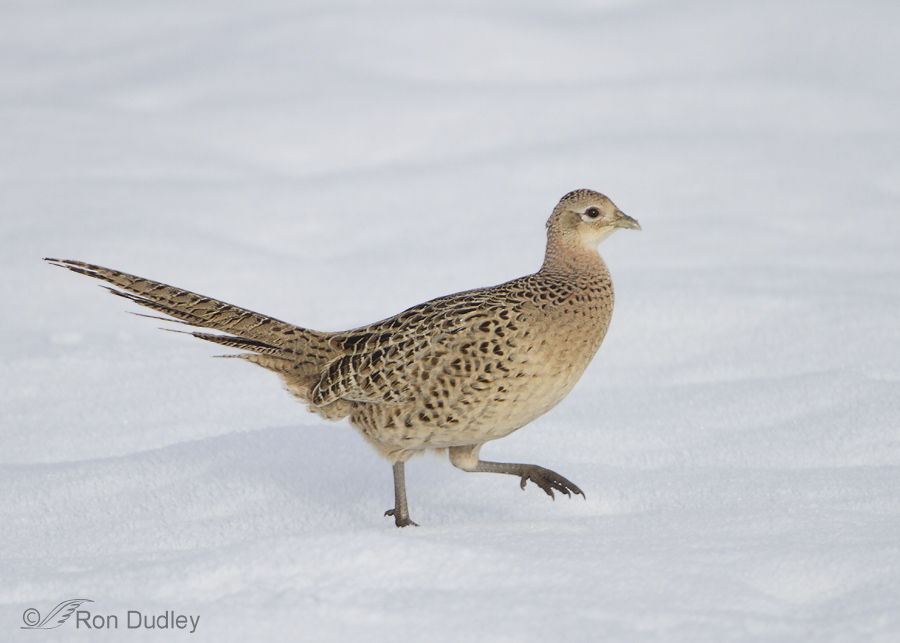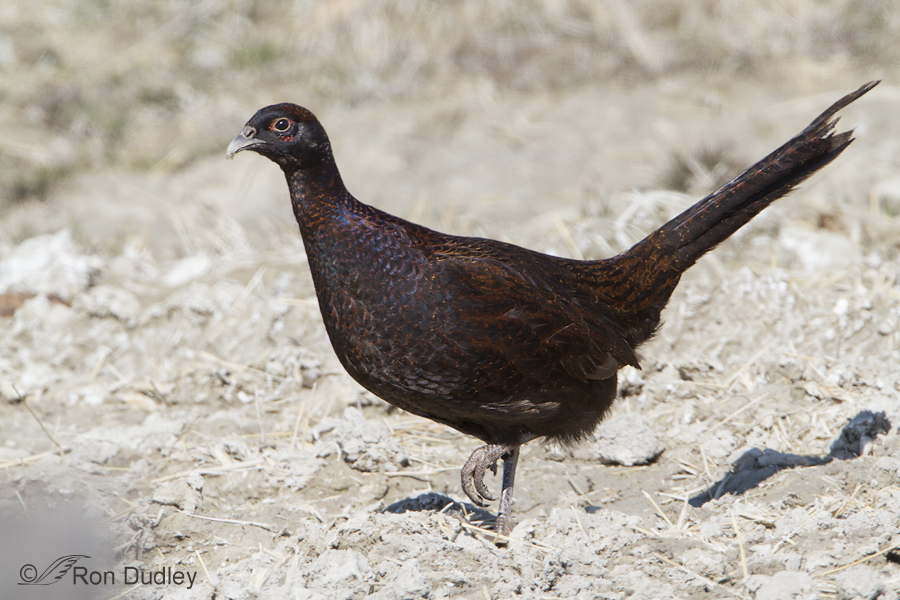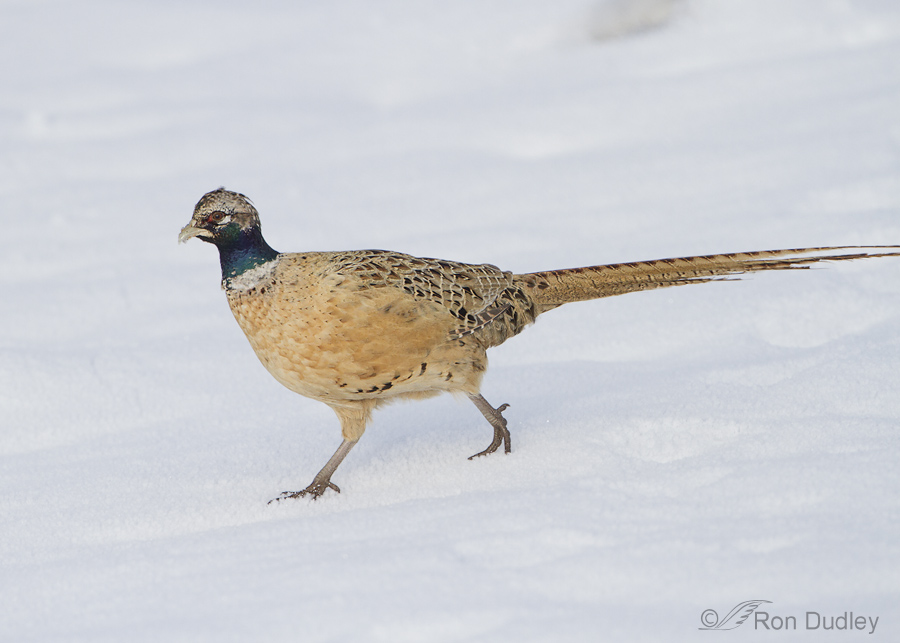Ring-necked Pheasants are relatively common in my area and I normally see very little variation in plumage color in them – males look like males, females look like females and that’s about it. But twice I’ve photographed some very strange-looking birds.
1/2000, f/7.1, ISO 400, Canon 7D, 500 f/4, 1.4 tc, not baited, set up or called in
Most folks know what they look like but here’s a couple of reminders. This is the male during winter.
1/3200, f/5.6, ISO 640, Canon 7D, 500 f/4, 1.4 tc, not baited, set up or called in
And here’s the female.
I’ve seen many thousands of pheasants in Utah (and Montana) over the years and only twice have I noticed significant variations in plumage from what you see in these first two images.
1/800, f/10, ISO 500, Canon 7D, 500 f/4, 1.4 tc, not baited, set up or called in
The first one was on 3/15/10 when I photographed this strikingly colored pheasant (at least I think it’s a pheasant but it sure has a sharply curved bill) near the entrance to the Antelope Island causeway. I believe the bird to be a female and she hung around the area for several days (image is full frame so I had no cropping/composition options).
1/2500, f/5.6, ISO 640, Canon 7D, 500 f/4, not baited, set up or called in
My second “unusual” pheasant was this male, photographed at Farmington Bay three days ago. The bird was foraging in the snow with a mixed group of “normal” Ring-necked Pheasants (and yes, I clipped the darn tail!).
I suppose it’s possible that either or both of these atypical pheasants are genetic anomalies of some sort but perhaps it’s more likely that the dark female is another species of pheasant (imported and escaped from captivity) and the male is a hybrid of some sort as it has at least some recognizable Ring-necked traits.
I’m aware that in some areas of the country (especially the Midwest?) a variety of pheasant breeds are imported and raised for release on game farms (a sore spot with me) for “sportsmen” to hunt so it may not be unusual to see a variety of plumage colors in those states. But around here it’s definitely out of the norm and these two birds certainly got my attention.
Ron






It is interesting what results sometimes! I’m not keen on the idea of breeding birds just to be shot at either – clay pigeons should be enough!
We have the typical flocks of mallards here around town, occasionally they will cross breed with domestic white or black ducks. That produces some very interesting variations, much like the second male. So would agree they are most likely hybrids of some sort. Excellent photos as always!
Thank you, Jeff.
How fascinating. I hope that they are the offspring of ‘escapees’. Killing for ‘fun’, killing as a sport does my head in. I find it incomprehensible. And killing for trophies I find obscene.
I’m not a fan of trophy hunting either, Elephant’s Child.
Looks like a melanistic mutant and likely a lucky escapee from a game farm, just as you surmised…alive to be shot another day.
Intriguing images! Re:”regular ” pheasants–I don’t remember the white on top of the head with our eastern pheasants. Different? Just poor memory? As for “game farms and “sportsmen”–why don’t they “man up” and shoot at each other. A lot more fair…and a lot more macho…and think of the trophies the survivors could hang on their walls!
Here is a link to a leucistic RT.
http://ctaudubon.blogspot.ca/2012/09/leucistic-red-tailed-hawk.html
I guess if this is a place were hunters are going to be bashed I will consider myself unwelcome. So thanks for the memories.
Bill
I have many friends who hunt for flood. They must to survive, and they do in a respectful manner. They don’t take taking a life lightly. They do not hunt for “sport”…as for those that do, I’d be more than happy to bash them! Killing for need, I understand. Killing for pleasure, I don’t.
I’m very sorry to hear you feel that way, Bill. I’ll miss your knowledgeable contributions here.
Personally I don’t generally have major issues with hunting when it’s done “ethically”, under regulation and it’s truly “fair chase”. Like many things, hunting has its pluses and minuses but there’s no question that hunting interests have done a lot for wildlife and habitat for generations. My own issues with certain aspects of hunting involve game farms, killing of predators (whether regulated or not) and “slob hunters” (I feel the same way about “slob photographers”). It’s a complicated issue that many folks on both sides feel deeply passionate about, that’s for sure.
On a forum like this one there’s going to be varying opinions on issues like this – it’s inescapable. I can’t see myself as a censor (not that you’ve asked) unless things go too far. Where that line is – I guess I won’t know until it is crossed.
I hope you’ll reconsider but if you don’t I wish you well. And thank you for your many contributions in the past – I’ll miss them.
I, too will miss Bill Dove’s incredible knowledge if he decides to exit…and I hope he doesn’t. My disdain is not for the man or woman who hunts to put meat on the table, but for those who hunt for the “thrill of the kill”…and for trophies to hang on their walls. I cannot understand killing for fun. We lived near a private game farm, that baited with salt licks and grain. The animals were used to humans providing food and were easily shot(and/or wounded), usually by “sports” who came up from the city for a days shooting. I have no respect for them. When someone needs the food, there is a fair “chase”, and the animal being hunted it shot quickly with minimal suffering, it is far better off than the critter in the stinking feed pen and the slaughter house….still, I think I’d rather eat the gun. I’ve patched up too many injured critters, I guess, to feel otherwise.
Snap. And so much better said, on all counts, than I could. Thank you Patty. And Bill, please don’t go – your knowledge is invaluable.
Patty, it seems to me that the whitish color on top of the head is more pronounced in winter with a black top surrounded by a white stripe during summer.
I remember seeing a white stripe, but nothing more. It was always exciting to find one of their beautiful long tail feathers, but they could make your heart stop when they’d explode in front of you as you walked through the fields….
There are melanistic pheasants but no partial albino birds (of any species). The term is leucistic (which refers to missing pigmentation which results in white feathers were there would normally be colored plumage. Albino involves much more that plumage.
Bill
That makes sense to me, Bill – especially if albinism in birds is like it is in humans where a recessive gene causes the expression of the traits (aa vs AA). Then it seems that truly albino birds would be incapable of producing melanin anywhere, not just in certain parts and there would be no partial expression.
I saw a male pheasant two days ago in my yard that was dark like your female photo with normal red and green and white ring markings on the head.
The darker body plumage appeared to be more blue/black than brown. Very odd. I live in the Willamette Valley in Oregon.
That male you saw sounds like a very odd “duck”, Ginny. Wish I could see it…
Super interesting to see a variation – especially of the male.
Always great photos, but I really like the little “proud prance” of the female in the 2nd photo.
Patricia, That “leg up” pose was the first step of the beginning of a run through the snow. I got a bunch of photos of it but she didn’t have much of a head turn toward me while she was running.
Very different indeed. Maybe the male is a partial albino? I got a pic two winters ago of a partial albino Common Redpoll. It was really beautiful. I’m with you though on the female, it looks like another species. Oh & HNY to you & Mia.
Thank you, Deb. Hope your New Year was great too.
I believe that Bill is correct (above) that there are “no partial albinos”.